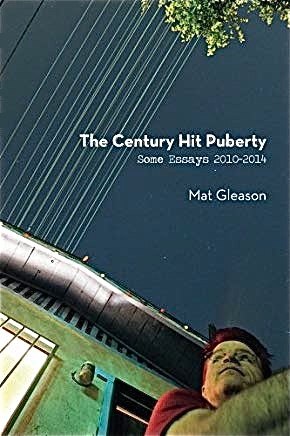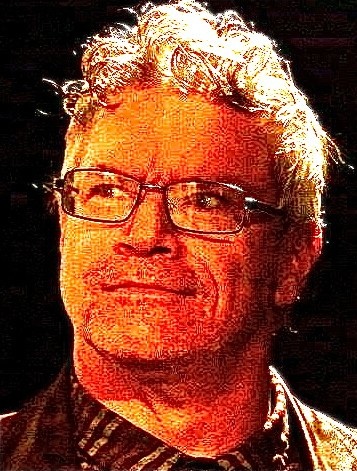Review of Mat Gleason’s
New Book
I just submitted this book review to Amazon of Mat Gleason's book.

Mat Gleason's The Century Hit Puberty: Some Essays 2010-2014 is a fantastic read, most of it. If it were a meal, it would be the best steak ever accompanied by overcooked mashed potatoes and green beans.
The book arrived in my mailbox via Amazon yesterday, and I inhaled it in one night, except for skimming the few boring chapters on music.

If Gleason were curating the chapters, he might have omitted the ones about Lou Reed, the Replacements and Leonard Cohen. The transition back and forth from music to fine art feels jarring and distracting.
If one is an artist and cannot make it to one of Gleason's annual L.A. art boot camps, this book would be a great substitute as a primer for thriving in the art world. Much of the first half reads like a manual from a coach to his most valued player. It flows with personal, comedic, and warm tones---caustic in parts, but with one's best interests in mind, as if Gleason is a big brother showing the ropes. For instance, he teaches the reader to delete one's birth year from their website to not scare away youth-obsessed collectors.
I admire Gleason's author's voice. He doesn't settle into a steady groove - through the years represented in this collection, one can feel him experimenting with various writing styles---some personal, and others quite rigorous…and some even downright Trumpian in his pithy attacks on vulnerable, overly exposed art world paragons.
In the first half of his volume, he hits the ball out the park, way out.
In Gleason's second half, he sadly bats .500, especially in the section entitled “410 Boyd- The curse of Cocola,” which in my first pass was totally unreadable.
The top paragraph on page 27 is one of the best I have ever read about art: “Europeans actually get Los Angeles. New Yorkers are just embarrassed to be here and try to network during most of their stay to pad their job history for the inevitable move back to Queens. This expansive survey of postwar Los Angeles contemporary art is the brainchild of tired New York academics. In sports, they call this East Coast Bias. The history of the Los Angeles art scene is getting the “gee whiz” media glance that Joe Torre got when he left managing the Yankees for the Dodgers. The clucking of the blizzard and brownstone crowd goes something like this: We just can't believe that everything does not happen in New York, but if you are going to commit suicide (the term New Yorkers use for leaving New York) you may as well enjoy exile in nice weather.”
Gee Whiz - It doesn't get any better than this, Gleason.
Gleason's use of wit and sarcasm treads a fine line; and he pulls it off. Many lesser writers would come off snarky and small. But like an old preacher employing his best sermon illustrations, he returns home to the main idea, and he doesn't get lost in the rabbit trail. He occasionally throws in a dose of humility (which may be rooted in his ongoing life of health struggles), which is endearing, and makes many of his body-slams more palatable.
Speaking of 'body-slams,' Gleason's first section, “You Genius You,” immediately knocks the artist/reader back on their duff putting them in their well-deserved place. Unlike Jesse Jackson, who constantly reiterates to his audiences that, “You are somebody,” Gleason posits, “Well, maybe you're not somebody. Take a realistic approximation of yourself. Maybe you and/or your art suck.”
It is obvious that Gleason does not think that Jerry Saltz sucks…. In fact, maybe unintentionally, Gleason's Saltz is the Yoda to his Skywalker; but in this case, the apprentice has become the master, especially in So Cal regional terms. Gleason is like the smallest soldier in his platoon---he can wriggle into small spaces into which Saltz cannot fit.
Gleason's lifetime of experiences in and around the So Cal art world informs his insider's guide to fishing - he knows where the best spots are.
Some of Gleason's shining moments include some very short individual bios of Dennis Hopper, Jackson Pollack, and Lucian Freud. The very best chapter by far is entitled “A Convergence of Four Art Critics.” It reads like a lovers' quarrel between three critics on Lumonol (Saltz, Gleason, and Robert Hughes), and one much lesser critic/troglodyte. If for nothing else, this chapter is worth the price of admission (It is the E-ticket of the entire book!).
When contrasted to his less compelling chapter on Diebenkorn's work, it makes one wonder if Gleason might be better at writing about art figures rather than the actual works themselves. His insertion of himself into the narrative in the “Convergence” section slyly compels the reader to root for Gleason (the gritty L.A. City College educated scribe) as he whomps against the quintessential stuffy Yale Art school professor. It feels like Rocky I---but instead of a boxing ring, Gleason weaves and bobs alone at his keyboard in his Huntington Park home. His wife, Ms. Salgado, calls from her office down the hall, “Mat, I see some typos!"
enough





